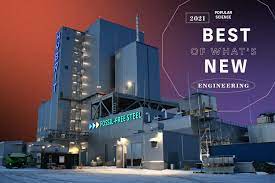From deadly floods in Queens, New York, to a deep-freeze in Texas, the climate crisis is banging on the US’s front door. This year’s top engineering innovations reflect a growing awareness that crucial industries like construction and shipping can no longer conduct business as usual. These honorees answer some of the burning questions about the future of a burning planet, including how to address tough-to-decarbonize realms like food and energy production. Outside of just green tech advancements, these technologies reveal safer ways to mine, introduce AI that can untangle hidden mysteries of DNA’s structure, and provide a much-needed dose of high-flying fun.
Steelmaking yields between seven and nine percent of the world’s carbon emissions, mostly due to a specially processed type of coal called “coke.” At temperatures as high as 3,000°F, coke reacts with oxygen in iron ore, purifying the metal into a form needed to make steel—but belching carbon dioxide in the process. To reduce the footprint, a Swedish industrial consortium developed Hybrit, a steel whose production taps hydrogen, rather than carbon, to transform iron ore. The hydrogen, freed from water, reacts with the oxygen in ore in a machine called a shaft furnace, heated to 1,500*F with fossil-free wind energy and hydropower. The scheme releases hydrogen and water, instead of carbon dioxide, and the resulting “sponge iron” melts in an electric arc furnace with a small amount of carbon to create steel. Hybrit says the process has carbon dioxide emissions less than 2 percent of those from the standard coke-fueled regimen. This past summer, Volvo took delivery of the first batch of this “green steel” and used it to make a mining and quarrying vehicle.
Container ships fuel our economy of cheap consumer goods, but create almost three percent of the world’s carbon dioxide emissions. Electric batteries don’t have the energy density to efficiently power the massive vessels—and plunking chargers in the middle of the ocean is pretty much impossible. This year, Finnish engine maker Wärtsilä teamed up with the Norwegian logistics giant Grieg to bet on carbon-free ammonia to propel future ships. Powered by a Norwegian wind farm, engineers will use electrolysis to create hydrogen gas that reacts with nitrogen in a factory to create ammonia. Wärtsilä already completed an engine burning a mix of 70 percent ammonia, and is planning a pure ammonia version to deploy in a tanker in 2024.
Global hunger for farmed shrimp has destroyed some 3.4 million acres of mangrove forests since 1980, mostly in Southeast Asia. Tearing apart those carbon-absorbing ecosystems gives the practice a footprint higher than dairy cattle, pigs, or chicken. Disease outbreaks and waterways choked with waste also plague the industry. The “Vertical Oceans” model takes the whole operation indoors. The shellfish live in modular school-bus sized tanks, and algae, seaweed, and bottom-feeding fish filter out waste. This way, nearly 100 percent of the water gets recirculated, and there is no need for a sewer. A prototype in Singapore delivered 10 harvests of shrimp this year, totaling more than a ton of crustaceans.
Source : https://www.popsci.com/technology/best-engineering-innovations-2021/








